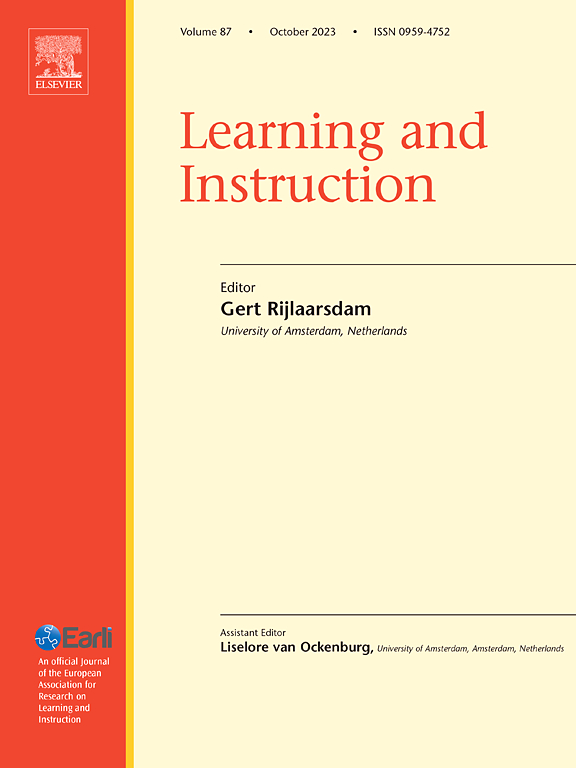Lightening the load: Unveiling the factors influencing teacher orchestration load in synchronous hybrid education
IF 4.9
1区 教育学
Q1 EDUCATION & EDUCATIONAL RESEARCH
引用次数: 0
Abstract
Background
Rapid technological developments and the Covid-19 pandemic have accelerated the adoption of synchronous hybrid education (SHE), where onsite and remote students participate in learning activities simultaneously. Despite its potential, many teachers remain hesitant to embrace this model due to the high orchestration demands. As teachers are the main actors in implementing SHE, it is essential to avoid unnecessary teacher orchestration load (TOL) when designing and delivering these lessons.
Aim
This study aims to gain a deeper understanding of the different components (RQ1) and influencing factors (RQ2) of TOL in SHE, and explores the relationship between these influencing factors and components (RQ3).
Sample
Participants were 21 university teachers with experience in SHE.
Methods
Semi-structured interviews using the Critical Incident Technique were conducted. Both a deductive approach to code the components and an abductive approach to identify the influencing factors were employed.
Results and conclusions
Regarding RQ1, teachers experience cognitive, emotional, and physical load during SHE. Regarding RQ2, 74 influencing factors were identified and categorized into six themes related to students, teachers, instructional design, institutional policies, technology, and the hybrid environment. Some factors consistently increase or decrease TOL (e.g., technical support decreases TOL), while other factors are associated with both an increase and a decrease in TOL, depending on context, time or teacher factors (e.g., small group work). Regarding RQ3, some factors relate to one component (e.g., ceiling microphones decrease physical load), while most relate to multiple components of TOL (e.g., chat messages increase cognitive and emotional load).
减轻负荷:揭示同步混合教育中教师编排负荷的影响因素
技术的快速发展和Covid-19大流行加速了同步混合教育(SHE)的采用,即现场和远程学生同时参与学习活动。尽管它很有潜力,但由于对编排的要求很高,许多教师仍然对采用这种模式犹豫不决。由于教师是实现SHE的主要参与者,因此在设计和交付这些课程时,必须避免不必要的教师编排负载(TOL)。目的深入了解SHE中TOL的不同组成部分(RQ1)和影响因素(RQ2),并探讨这些影响因素与组成部分(RQ3)之间的关系。样本参与者为21名具有SHE经验的大学教师。方法采用关键事件技术进行半结构化访谈。采用演绎法对构件进行编码,采用溯因法对影响因素进行识别。结果与结论在RQ1中,教师在SHE中经历了认知、情绪和身体负荷。关于RQ2,确定了74个影响因素,并将其分为与学生、教师、教学设计、制度政策、技术和混合环境相关的6个主题。有些因素会持续增加或减少TOL(例如,技术支持会降低TOL),而其他因素则与TOL的增加或减少有关,具体取决于环境、时间或教师因素(例如,小组工作)。关于RQ3,一些因素与一个组成部分有关(例如,天花板麦克风降低了物理负荷),而大多数因素与TOL的多个组成部分有关(例如,聊天信息增加了认知和情绪负荷)。
本文章由计算机程序翻译,如有差异,请以英文原文为准。
求助全文
约1分钟内获得全文
求助全文
来源期刊

Learning and Instruction
Multiple-
CiteScore
11.30
自引率
4.80%
发文量
109
期刊介绍:
As an international, multi-disciplinary, peer-refereed journal, Learning and Instruction provides a platform for the publication of the most advanced scientific research in the areas of learning, development, instruction and teaching. The journal welcomes original empirical investigations. The papers may represent a variety of theoretical perspectives and different methodological approaches. They may refer to any age level, from infants to adults and to a diversity of learning and instructional settings, from laboratory experiments to field studies. The major criteria in the review and the selection process concern the significance of the contribution to the area of learning and instruction, and the rigor of the study.
 求助内容:
求助内容: 应助结果提醒方式:
应助结果提醒方式:


